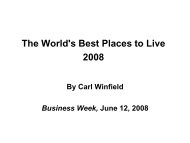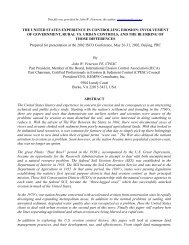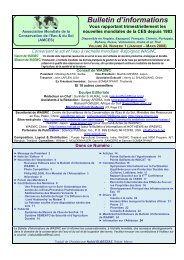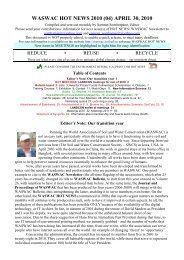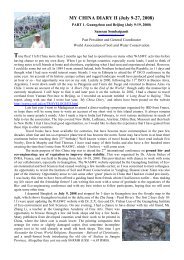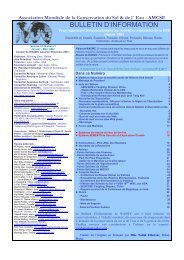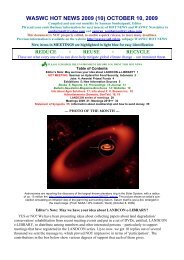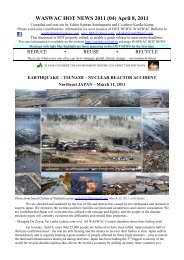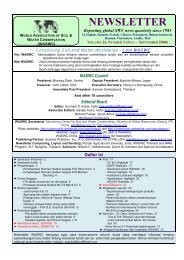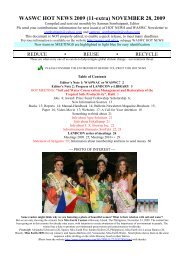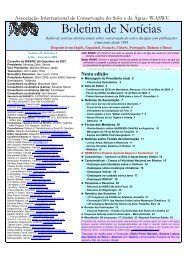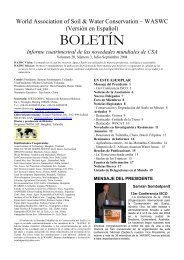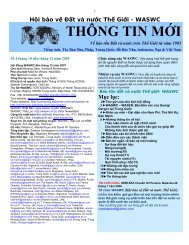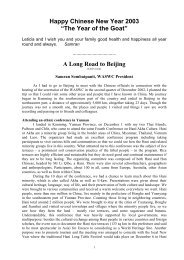Soils of the European Union - European Soil Portal - Europa
Soils of the European Union - European Soil Portal - Europa
Soils of the European Union - European Soil Portal - Europa
Create successful ePaper yourself
Turn your PDF publications into a flip-book with our unique Google optimized e-Paper software.
3. <strong><strong>Soil</strong>s</strong> <strong>of</strong> <strong>the</strong> <strong>European</strong> <strong>Union</strong>: an overviewA great variety <strong>of</strong> climatic, topographical and geological conditions, toge<strong>the</strong>r with <strong>the</strong> diverse anthropogenic influences hasresulted in a diverse soil cover in Europe (Map 3.1). The fact that twenty-three out <strong>of</strong> <strong>the</strong> total <strong>of</strong> thirty Reference <strong>Soil</strong>Groups (WRB 1998) <strong>of</strong> <strong>the</strong> world have representative in <strong>the</strong> EU shows <strong>the</strong> magnitude <strong>of</strong> this diversity. However, not allsoil types have <strong>the</strong> same share in <strong>the</strong> soil coverage <strong>of</strong> <strong>the</strong> EU. While <strong>the</strong> most widespread Reference <strong>Soil</strong> Group –Cambisols – has a proportion <strong>of</strong> nearly 27 % <strong>of</strong> <strong>the</strong> total area, Umbrisols can be found on very limited areas (329 km 2 ).Table 3.1 shows <strong>the</strong> summarized extent <strong>of</strong> Reference <strong>Soil</strong> Groups in <strong>the</strong> EU.Table 3.1 Spatial extent <strong>of</strong> Reference <strong>Soil</strong> Groups (WRB 1998) in <strong>the</strong> <strong>European</strong> <strong>Union</strong>Reference <strong>Soil</strong> Group km 2 % <strong>of</strong> <strong>the</strong> totalAcrisols 10626 0.26Albeluvisols 76865 1.85Andosols 8705 0.21Anthrosols 3428 0.08Arenosols 149776 3.61Calcisols 9288 0.22Cambisols 1107598 26.71Chernozems 78492 1.89Fluvisols 221669 5.35Gleysols 219781 5.30Gypsisols 4110 0.10Histosols 268741 6.48Kastanozems 3532 0.09Leptosols 435713 10.51Luvisols 610941 14.74Phaeozems 70439 1.70Planosols 18981 0.46Podzols 566874 13.67Regosols 222322 5.36Solonchaks 11728 0.28Solonetzes 9857 0.24Umbrisols 329 0.01Vertisols 36447 0.88Total soil cover: 4146242 100As can be seen from <strong>the</strong> table, <strong>the</strong> soils sum up to 4,146,242 km 2 , thus to more than 95 % <strong>of</strong> <strong>the</strong> total surface area(4,324,782 km 2 ) <strong>of</strong> <strong>the</strong> EU. The remaining 5% is occupied by <strong>the</strong> non-soil land cover types such as large continuous builtup areas, water bodies and glaciers.Twenty-two Reference <strong>Soil</strong> Groups are dominant (≥ 50 %) in some or in several mapping units. Anthrosols are exceptions;as this Reference <strong>Soil</strong> Group never dominates mapping units at <strong>the</strong> 1:1 million scale in Europe.Following <strong>the</strong> Cambisols Reference <strong>Soil</strong> Group <strong>the</strong> second most widespread is that <strong>of</strong> Luvisols. Luvisols, like Cambisols,can be found in all parts <strong>of</strong> <strong>the</strong> continent in associations with o<strong>the</strong>r Reference <strong>Soil</strong> Groups. Podzols have similar area toLuvisols. However, this Reference <strong>Soil</strong> Group is mainly concentrated in nor<strong>the</strong>rn Europe. Leptosols, <strong>the</strong> forth largestReference <strong>Soil</strong> Group, on <strong>the</strong> contrary, have smaller shares in <strong>the</strong> nor<strong>the</strong>rn regions. Spatial extent <strong>of</strong> Histosols, Regosols,Fluviols, Gleysols and Arenosols ranges around 5 % within <strong>the</strong> EU. However, while Histosols, Gleysols and Arenosols arepredominantly soils <strong>of</strong> <strong>the</strong> Nor<strong>the</strong>rn regions, most <strong>of</strong> Regolols can be found in <strong>the</strong> sou<strong>the</strong>rn parts <strong>of</strong> Europe. Fluvisols arepredominant in <strong>the</strong> river basins in all parts <strong>of</strong> <strong>the</strong> continent. Albeluvisols have similar areal coverage (~ 2%) withChernozems and Phaeozems, however fundamentally different pedological features. Reference <strong>Soil</strong> Groups with smallerareal extent (< 1%) include soils with special abilities for performing important soil functions.9



